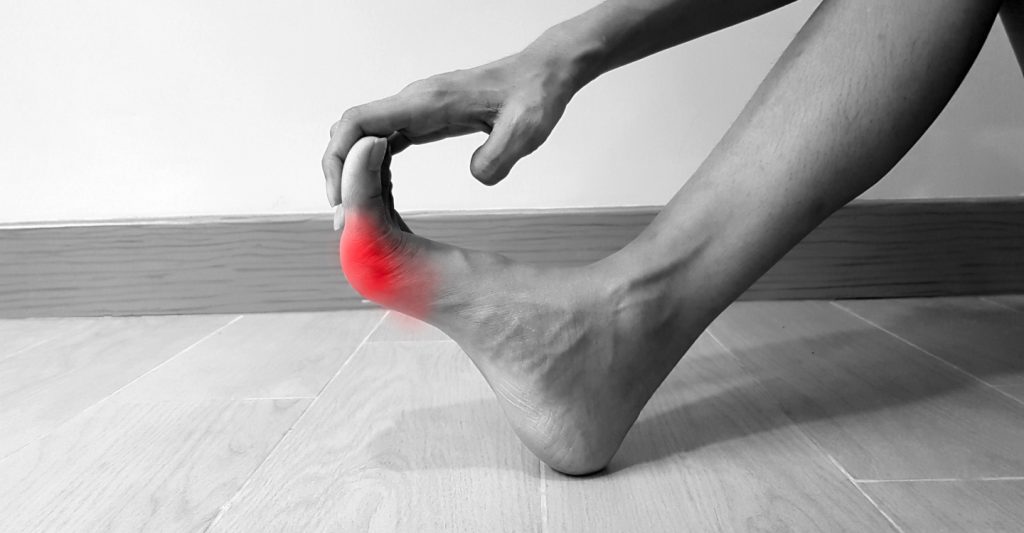Plantar fasciitis is the most common cause of foot pain, radiating from the bottom of the heel throughout the foot.
The plantar fascia is a ligament that connects the inside of the heel bone to the toes. It supports the arch on the underside of the foot and absorbs strains we place on our foot while we stand or walk. Plantar Fasciitis usually develops when the plantar fascia is stretched beyond its normal range or sprained, causing small tears and inflammation. It is a relatively common injury among runners and individuals whose jobs require standing for long periods.
However, if left untreated, it can cause serious complications.
Here, we will discuss things you must know about plantar fasciitis, the consequences of untreated plantar fasciitis, and how healing plantar fasciitis without surgery is possible.
Symptoms
Symptoms of plantar fasciitis include:
• Heel pain is worse in the morning but gradually subsides as the day progresses.
• Pain after standing on your feet for long periods.
• Pain when standing after resting.
• Pain when you extend your toes.
• Swelling.
Diagnosis
With early intervention, healing plantar fasciitis without surgery is possible. However, it is best to speak with a Florida foot and ankle specialist to discuss your symptoms so they can evaluate the condition and provide the best treatment options.
So, do not hesitate to contact the physician if you have stabbing and persistent heel pain.
Risks Of Leaving Plantar Fasciitis Untreated
Symptoms of plantar fasciitis usually develop gradually, but if you ignore the signs, the injury and inflammation will likely aggravate, leading to more severe complications where treatment will become more arduous.
Here are the risks of untreated plantar fasciitis:
Plantar tears
When you leave plantar fasciitis untreated, the inflammation and stress on the plantar fascia can cause small micro tears. You may not be aware of these small tears as they arise until the pain becomes worse. These tears can grow in size and number if left untreated, causing complications.
Plantar rupture
Plantar ruptures occur when you continue placing heavy impacts on the fascia. These activities include running, other sports, or even standing for a long time.
The symptoms of plantar rupture include loud popping followed by intense pain, swelling, and bruising in the foot. If you continue to put weight on the affected foot, it can worsen the pain. So, immediately seek medical help.
Heel Spurs

Heel spurs are a typical response to untreated plantar fasciitis. The body generates calcium and deposits it on the foot’s arch to protect it from damage. Over time, these calcium deposits create sharp protrusions and cause pain with each step.
Plantar fibromatosis
It is a condition where benign nodules grow slowly along the plantar fascia. They may go unnoticed in the early stages until they suddenly proliferate. Over time as the nodules grow, walking may become painful and uncomfortable.
Hip, knee, and back pain
The arches of the feet work with the lower body’s tendons, ligaments, and muscles. When the plantar fascia becomes compromised, other muscles, ligaments, and tendons work harder to compensate. Overusing other body parts can eventually lead to hip, knee, and back pain.
How Bad Can Plantar Fasciitis Get?
Most people ignore the symptoms of plantar fasciitis until it begins to affect their ability to maintain daily activities and their quality of life. Consequently, when they seek treatment, many patients with untreated Plantar Fasciitis have already developed a severe disability.
Diagnosis
Recognizing plantar fasciitis symptoms early on is the best way to avoid complications.
It is diagnosed based on your medical history and physical examination.
The doctor may order imaging tests to ensure the pain is not due to a stress fracture.
Treatment
Most people with plantar fasciitis recover in several months with conservative treatment. The treatment methods include rest, massage, stretchering, taping, and wearing supportive footwear, shoe inserts, and night splints.
You can also manage pain with over-the-counter medications like aspirin, ibuprofen, and naproxen. So, from the above, healing plantar fasciitis without surgery is possible. However, the longer you delay treatment, the less likely you will improve from conservative treatment.
As you continue to overload the ligament, the injury and inflammation continue to develop, and all the symptoms of plantar fasciitis become more severe. In that case, you may require surgical treatment.
Signs Plantar Fasciitis Is Healing
With conservative treatment, your body will gradually repair the injury, and inflammation will subside. Within a few weeks, you will notice that swelling in the heel has reduced and that pain has become less severe and less frequent. You can sit for more extended periods without feeling that sharp heel pain during the first steps after you stand up.
With time, you will stop feeling heel pain when you leave the bed in the morning.
If you, too, experience heel pain that dissipates once you start walking around, schedule an appointment with Foot, Ankle & Leg Vein Center. We have a top podiatrist Boynton Beach who is dedicated and experienced in getting to the root of your heel pain and treating it with conservative treatment.



